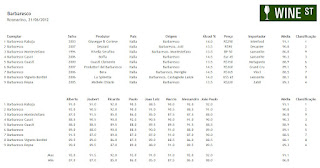Na
última 5ª feira, dia 21 de junho, realizamos mais uma degustação no Rosmarino.
Tivemos a presença de 8 confrades. Foram degustados 9 vinhos, das safras 1996,
2000, 2003, 2005, 2006 e 2007, representando diversas sub-regiões de
Barbaresco, entre elas: Montestefano, Asti, Neviglie, Castagnole Lanze, alem
dos Vinhedos Bordini e Rabajá. Como de costume, o nosso menu foi escolhido pelo
nosso confrade Paulo e estava excepcional.
Os
vinhos harmonizaram muito bem com o menu escolhido.
Couvert: Pães
especiais da casa e manteiga
Entradas:
Sopinha de creme de funghi
Primeiro prato:
Raviolone de ricota e espinafre al uovo, salteado na manteiga de tartufo.
Prato principal:
Stinco de vitela com purê de batata e alho poró.
Sobremesa:
Entremet de chocolate, Torta de nozes carameladas, Merengue de chocolate belga
e avelãs, Carolinas de creme, Ovos nevados, Tiramisú, Creme brulée, Pastiera di
grano, Bavarese de chocolate e Tarte Tatin
Como
de costume, o ambiente, a comida e o serviço estavam excelentes..
A
degustação contou com nove vinhos, com níveis alcoólicos variando entre 13,5% e
14,5%.
A
seguir uma breve descrição dos vinhos degustados:
Barbaresco
Rabaja 2003
Produtor: Giuseppe & Cortese
País/Região: Italia/Barbaresco
Graduação alcoolica: 14%
Uvas: Nebbiolo
Confrade: Paulo
Barbaresco
2007
Produtor: Dezzani
País/Região: Italia/Barbaresco, Asti
Graduação alcoolica: 13.5%
Uvas: Nebbiolo
Confrade: João Paulo
Barbaresco
Montestefano 1996
Produtor: Rivella Serafino
País/Região: Italia/Barbaresco, Montestefano
Graduação alcoolica: 13.5%
Uvas: Nebbiolo
Confrade: Alessandro
Barbaresco
Casot 2006
Produtor: Boffa
País/Região: Italia/Barbaresco
Graduação alcoolica: 14.5%
Uvas: Nebbiolo
Confrade: Ricardo
Barbaresco
Guasti 2000
Produtor: Guasti Clemente
País/Região: Italia/Barbaresco
Graduação alcoolica: 13.5%
Uvas: Nebbiolo
Confrade: Marcio
Barbaresco
2007
Produtor: Produttori del Barbaresco
País/Região: Italia/Barbaresco
Graduação alcoolica: 14.5%
Uvas: Nebbiolo
Confrade: Joubert
Barbaresco
2006
Produtor: Bera
País/Região: Italia/Barbaresco, Neviglie
Graduação alcoolica: 14.5%
Uvas: Nebbiolo
Confrade: João Luiz
Barbaresco
Vigneto Bordini 2006
Produtor: La Spinetta
País/Região: Italia/Barbaresco, Castagnole Lanze
Graduação alcoolica: 14%
Uvas: Nebbiolo
Confrade: Marcio
Barbaresco
Reyna 2005
Produtor: Michele Chiarlo
País/Região: Italia/Barbaresco
Graduação alcoolica: 13.5%
Uvas: Nebbiolo
Confrade: Alberto
Vinhos
degustados
O
Barbaresco é um vinho tinto aristocrático, classificado como DOCG em 1980. Seus
vinhedos estão situados no Langhe, no lado direito do rio Tanaro e se extendem
da área a nordeste de Alba às comunas de Barbaresco, Nieve e Treiso, bem como
San Rocco Senodelvio. A variedade dominante é a Nebbiolo. A Nebbiolo, cujo nome
vem de Nebbia (neblina) é uma casta tinta que produz um vinho quando jovem de
forte acidez e taninos muito firmes, cor vermelho escuro com bordas atijoladas,
aromas de especiarias, ameixa, cereja e tostado da madeira na qual estagiou.
Nesta
degustação, os resultados do nosso painel apresentaram, uma amplitude de notas em
linha com degustaçãoes anteriores, sendo na média aparada de 4,3 pontos (de 86,8
a 91,1).
O
vinho que ficou em último lugar foi o Barbaresco
Montestefano 1996, produzido por Rivella Serafino, na região de Montestefano,
com 13,5% de alcool, escolhido o pior vinho por seis confrades e o melhor por
um.
O
segundo melhor vinho do painel, foi o Barbaresco
Dezzani 2007, produzido pela vinicola Dezzani na região de Asti. Este vinho, com 13,5% de alcool, foi produzido com as
uvas Nebbiolo. Foi considerado o melhor vinho por 3 confrades e o segundo
melhor por outros dois.
O Campeão da noite, foi o Barbaresco Rabajá 2003, produzido por Giuseppe & Cortese na região de Barbaresco,
com uvas do vinhedo Rabajá, que ficou em primeiro lugar para 3 confrades e em
segundo para outros 2.
Vejam
os resultados completos abaixo.
Não
se esquecam que o nosso próximo encontro será no dia 19 de julho,
quando degustaremos Malbec Top. Até lá....
Não
percam a próxima degustação.








